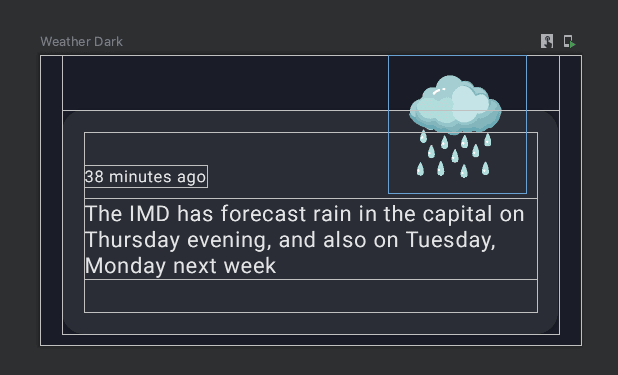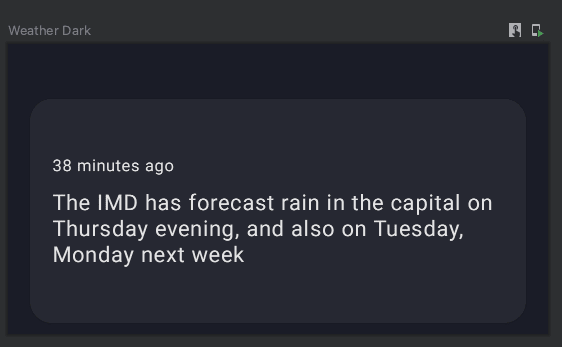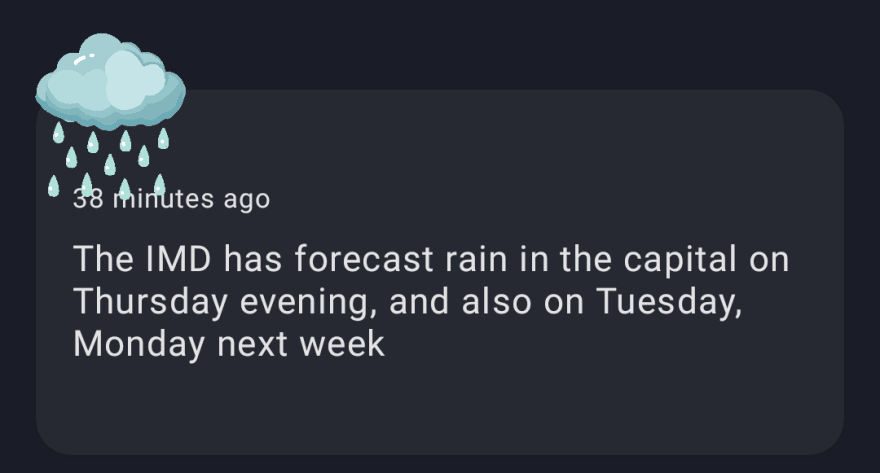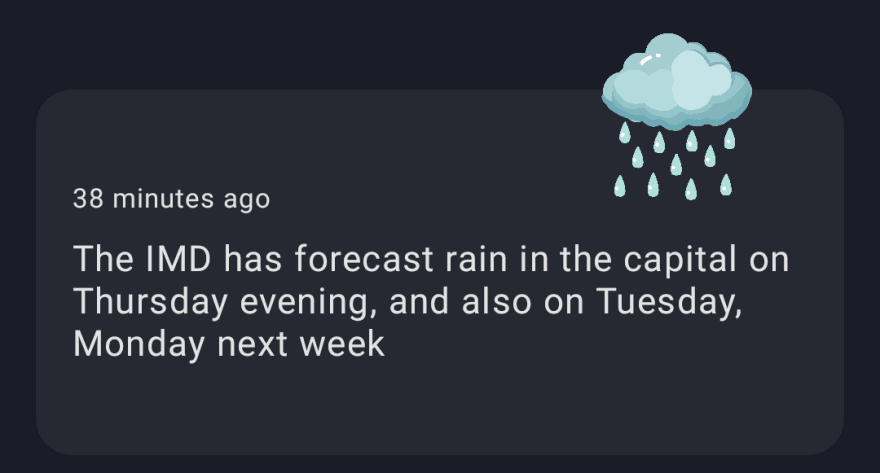An Interest In:
Web News this Week
- April 1, 2024
- March 31, 2024
- March 30, 2024
- March 29, 2024
- March 28, 2024
- March 27, 2024
- March 26, 2024
Weather forecast card design using Jetpack Compose
Cross posting from my blog
Weather forecast card design using Jetpack Compose
Horizontal weather cards are the second portion in my forecast screen. It contains a message, relative timestamp and an image depicting the weather. Since I don't have images in handy, I picked one and used for all the cards. I got creative with messages though.
Why box layout?
We have card and an image stacked in z order and they overlap. A constraint layout can be used to build this card, but I wanted to try box. It's like FrameLayout to me. Also using constraint layout for simple layout is an overkill. Be it android native UI or Compose.
Designing a Weather Card
The overall composable blueprint looks like in below image. To understand better, let's build this layout bottom-up.
...
Card content
// card contentColumn(modifier = Modifier.padding(16.dp)) { Spacer(modifier = Modifier.height(24.dp)) // Time Text( text = time, // "20 minutes ago", style = MaterialTheme.typography.caption ) Spacer(modifier = Modifier.height(8.dp)) // Message Text( text = message, // "If you don't want to get wet today, don't forget your umbrella.", style = MaterialTheme.typography.body1 ) Spacer(modifier = Modifier.height(24.dp))}Two labels wrapped in a Column with spacer makes our card content. Spacers are added in between the elements to make up required spacing between the labels and the parent (Column).
...
Card design
Now put a card around it and apply few modifiers to it.
- a shape
RoundedCornerShape - top padding to make space for weather icon on top right
Card( shape = RoundedCornerShape(16.dp), modifier = Modifier .padding(top = 40.dp, start = 16.dp, end = 16.dp, bottom = 8.dp)) { Column(...)}...
Putting all in a Box
Box layout stacks all the elements in given z order. Most recent one will be on the top. So, let's put the Card first then the Image.
Box { Card(...) Image( painter = painterResource(id = R.drawable.cloudy), contentDescription = "weather overlap image", modifier = Modifier .size(100.dp) )} Hmm... The rain wasn't supposed to shower there. Let's pull it to the right and shift a bit to the left. Children of Box has access to few properties to help with alignment inside the container.
- alignment
Alignment.TopEnd - offset
x = (-40).dpnegative translation in horizontal direction
Image( painter = painterResource(id = R.drawable.cloudy), contentDescription = "weather overlap image", modifier = Modifier .size(100.dp) .align(alignment = Alignment.TopEnd) .offset(x = (-40).dp))Horizontal pager implementation
Google accompanist has an incredibly good set of extension for compose. To implement the pager & indicator, we need corresponding dependencies added to our codebase.
implementation "com.google.accompanist:accompanist-pager:0.9.0"implementation "com.google.accompanist:accompanist-pager-indicators:0.9.0"Next step is to wrap the pager and indicator inside a Column and provide a list of mock objects to the render in WeatherCard that we built in above section.
fun WeatherCardCarousal(cards: List<WeatherCard>) { val pagerState = rememberPagerState(pageCount = cards.size) Column { HorizontalPager( state = pagerState ) { page -> WeatherUpdateCard(cards[page]) } HorizontalPagerIndicator( pagerState = pagerState, modifier = Modifier .align(Alignment.CenterHorizontally) .padding(16.dp), ) }}pagerStateprovides the current index of element for theHorizontalPagerWeatherUpdateCard(cards[page])with the given index, corresponding element picked from mock data and rendered in WeatherCardHorizontalPagerIndicatorplaced below the pager to react with page swipes in Pager. If it needs to be overlapped on the Pager. We'll wrap them inside a Box and align it.
This is again an example for thinking in compose. Pager updates the pagerState, and PagerIndicator reads the same. Both of 'em doesn't know other component exist. Decoupled and yet communicating.
Here, the complete gist.
Happy composing!!
Original Link: https://dev.to/mahendranv/weather-forecast-card-design-using-jetpack-compose-2m1h
Dev To
 An online community for sharing and discovering great ideas, having debates, and making friends
An online community for sharing and discovering great ideas, having debates, and making friendsMore About this Source Visit Dev To







